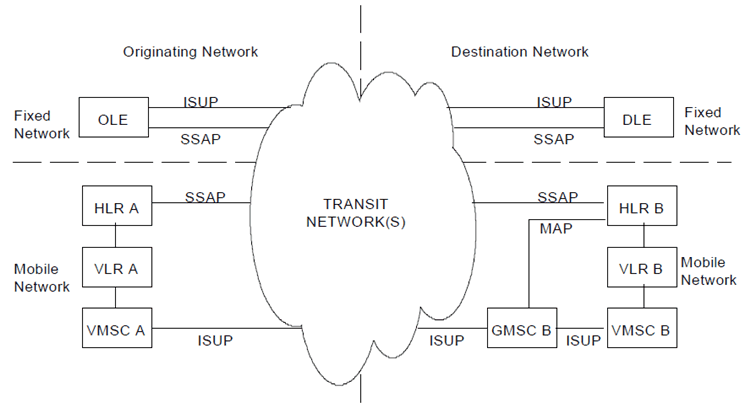Content for TS 23.093 Word version: 18.0.0
1 Scope
2 Normative references
3 Definitions and abbreviations
3.1 Definitions
3.2 Abbreviations
4 General
4.1 Overview
4.2 Architecture
...
...
1 Scope p. 6
This Technical Specification gives the stage 2 description of the Completion of Calls to Busy Subscriber (CCBS) supplementary service.
2 Normative references p. 6
The following documents contain provisions which, through reference in this text, constitute provisions of the present document.
- References are either specific (identified by date of publication, edition number, version number, etc.) or non specific.
- For a specific reference, subsequent revisions do not apply.
- For a non-specific reference, the latest version applies. In the case of a reference to a 3GPP document (including a GSM document), a non-specific reference implicitly refers to the latest version of that document in the same Release as the present document.
[1]
TR 21.905: "3G Vocabulary".
[2]
TS 22.030: "Man Machine Interface (MMI) of the Mobile Station (MS)".
[3]
TS 22.093: "Completion of calls to busy subscriber (CCBS) supplementary services - Stage 1".
[4]
TS 23.011: "Technical realization of supplementary services - General Aspects".
[5]
TS 23.018: "Basic Call Handling - Technical Realization".
[6]
TS 23.078: "Customised Applications for Mobile network Enhanced Logic (CAMEL) - Stage 2".
[7]
TS 23.079: "Support for Optimal Routeing (SOR) - Technical Realization".
[8]
TS 24.008: "Mobile radio interface layer 3 specification; Core Network Protocols Stage3".
[9]
TS 29.002: "Mobile Application Part (MAP) specification".
[10]
ETSI ETS 300 358: "ISDN Completion of Calls to Busy Subscriber (CCBS) supplementary service; Functional capabilities and information flows".
3 Definitions and abbreviations p. 6
3.1 Definitions p. 6
Destination B:
The entity addressed in the original call set up, which is busy when first called by subscriber A. Similarly, MSC B, VLR B and HLR B are the network elements pertaining to Destination B when Destination B is a GSM mobile.
Originating queue:
The queue that manages CCBS requests for a subscriber, when that subscriber is the originator of those CCBS Requests.
SSAP:
Supplementary Service Application Part. SSAP is the protocol used for CCBS procedures on the interface between the originating and destination network. Communication across this interface is performed using SCCP Connectionless Signalling (Refer to ETS 300 358).
Subscriber A:
The user of MS A, requesting CCBS. Similarly, MSC A, VLR A and HLR A are the network elements pertaining to Subscriber A.
Subscriber B:
The user of destination B, who may not necessarily subscribe to CCBS.
Subscriber C:
The user of MS C, who is the forwarded-to-party when call forwarding applies. Similarly, MSC C, VLR C and HLR C are the network elements pertaining to Subscriber C.
Target queue:
The queue that manages CCBS requests for a subscriber, when that subscriber is the target of CCBS Requests.
Timers:
For each of the service timers, the location, start and stop conditions and action on expiry are given - Refer to clause 5.1.
3.2 Abbreviations p. 7
Abbreviations used in this specification are listed in TR 21.905.
4 General p. 7
4.1 Overview p. 7
The CCBS service allows a calling subscriber A, encountering a NDUB destination B, to be notified when destination B becomes idle and to have the network automatically generate a CCBS call to destination B, if subscriber A desires. Subscriber A may make distinct CCBS requests for calls to the same destination B for different basic services.
4.2 Architecture p. 7
Figure 4.2.1 is an architectural overview of the CCBS service when interworking between the originating and the destination networks involved. The originating network may be a mobile network or a fixed network and the destination network may also be a mobile network or a fixed network.
The call related signalling for CCBS is performed on ISUP links on the following interfaces:
VMSC A - GMSC B;
VMSC A - DLE;
OLE - GMSC B;
whereas the specific CCBS procedures are performed via the SSAP protocol, which is signalled on the following interfaces:
HLR A - HLR B;
HLR A - DLE;
OLE - HLR B.

Figure 4.2.1: Architectural overview showing common point of interworking
(⇒ copy of original 3GPP image)
(⇒ copy of original 3GPP image)
4.2.1 Architectural overview during roaming p. 8
Either the originating subscriber A or the destination subscriber B or both may be located outside of their HPLMNs during the CCBS service. When all the involved networks support CCBS service the normal handling described in this specification applies. When some network entities do not support CCBS service refer to clause 10 where the exceptions are described in more detail.
The signalling between different networks described in the clause 4.2 applies also during roaming. HLR A and HLR B belongs always to the HPLMN of the subscriber whereas VLR A and MSC A and GMSC, VLR B and MSC B respectively may belong to a HPLMN or VPLMN. Refer to TS 23.018 where call handling in the mobile network is described in more detail.